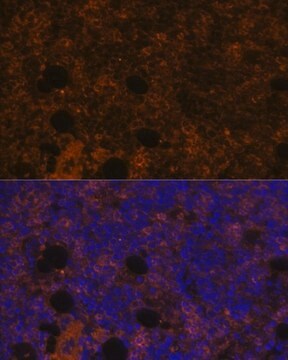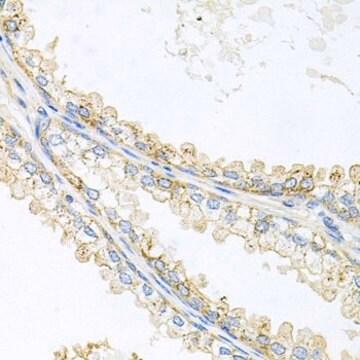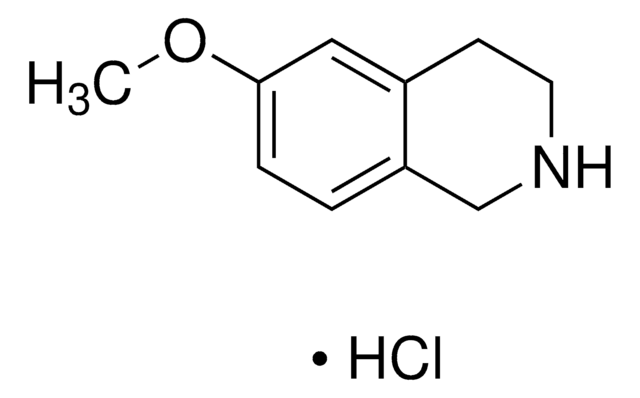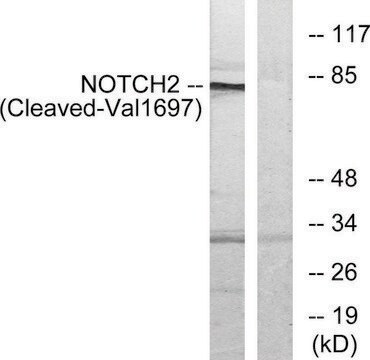MAB10207
Anti-Fusion Glycoprotein of Human parainfluenzavirus Type 3 Antibody, clone 9-4-3
ascites fluid, clone 9-4-3, Chemicon®
Sinonimo/i:
PI3
Autenticatiper visualizzare i prezzi riservati alla tua organizzazione & contrattuali
About This Item
Codice UNSPSC:
12352203
eCl@ss:
32160702
NACRES:
NA.41
Clone:
9-4-3, monoclonal
application:
IF
Reattività contro le specie:
human
tecniche:
immunofluorescence: suitable
citations:
5
Prodotti consigliati
Origine biologica
mouse
Livello qualitativo
Forma dell’anticorpo
ascites fluid
Tipo di anticorpo
primary antibodies
Clone
9-4-3, monoclonal
Reattività contro le specie
human
Produttore/marchio commerciale
Chemicon®
tecniche
immunofluorescence: suitable
Isotipo
IgG1
N° accesso UniProt
Condizioni di spedizione
wet ice
Descrizione generale
Human parainfluenza virus type 3 (PI3 virus) causes mild to severe respiratory tract infection in infants. PI3 virus is an enveloped RNA virus and possesses two glycoproteins, hemagglutinin-neuraminidase (HN) and fusion (F), at its external surface. These two glycoproteins are known to be responsible for initiation and progress of the infection process
Immunogeno
Fusion (F) glycoprotein of human parainfluenzavirus type 3
Note legali
CHEMICON is a registered trademark of Merck KGaA, Darmstadt, Germany
Non trovi il prodotto giusto?
Prova il nostro Motore di ricerca dei prodotti.
Codice della classe di stoccaggio
10 - Combustible liquids
Classe di pericolosità dell'acqua (WGK)
WGK 1
Punto d’infiammabilità (°F)
Not applicable
Punto d’infiammabilità (°C)
Not applicable
Certificati d'analisi (COA)
Cerca il Certificati d'analisi (COA) digitando il numero di lotto/batch corrispondente. I numeri di lotto o di batch sono stampati sull'etichetta dei prodotti dopo la parola ‘Lotto’ o ‘Batch’.
Possiedi già questo prodotto?
I documenti relativi ai prodotti acquistati recentemente sono disponibili nell’Archivio dei documenti.
M A Horga et al.
Journal of virology, 74(24), 11792-11799 (2000-11-23)
Viral interference is characterized by the resistance of infected cells to infection by a challenge virus. Mechanisms of viral interference have not been characterized for human parainfluenza virus type 3 (HPF3), and the possible role of the neuraminidase (receptor-destroying) enzyme
Antiviral effects of glycosylation and glucose trimming inhibitors on human parainfluenza virus type 3
Tanaka, Yoshikazu, et al
Antiviral research, 72, 1-9 (2006)
Laura M Palermo et al.
Journal of virology, 83(13), 6900-6908 (2009-04-24)
Three discrete activities of the paramyxovirus hemagglutinin-neuraminidase (HN) protein, receptor binding, receptor cleaving (neuraminidase), and triggering of the fusion protein, each affect the promotion of viral fusion and entry. For human parainfluenza virus type 3 (HPIV3), the effects of specific
Wenyan Xie et al.
PloS one, 10(8), e0136474-e0136474 (2015-08-26)
Human parainfluenza virus type 3 (HPIV3) can cause severe respiratory tract diseases in infants and young children, but no licensed vaccines or antiviral agents are currently available for treatment. Fusing the viral and target cell membranes is a prerequisite for
Il team dei nostri ricercatori vanta grande esperienza in tutte le aree della ricerca quali Life Science, scienza dei materiali, sintesi chimica, cromatografia, discipline analitiche, ecc..
Contatta l'Assistenza Tecnica.








